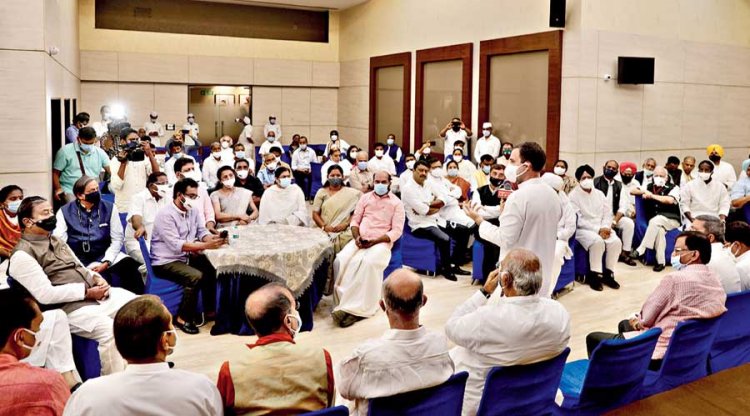Opposition Leaders Pledge to Unite
STORIES, ANALYSES, EXPERT VIEWS

Rahul Gandhi Tuesday led a group of MPs, cycled to Parliament to draw attention to rising prices. After a meeting at which Opposition leaders, he pledged to unite and fight the Narendra Modi re-gime.
While Rahul’s tractor ride to Parliament last week symbolised the farmers’ struggle against the gov-ernment’s obduracy on the three controversial farm laws, the bicycle was used to amplify the agony of the common man burdened by abnormally high prices of essential commodities, including petro-leum products.
At the meeting, every Opposition leader stressed the need for unity, with Rahul pointing out that the government was able to bulldoze the Opposition that represents 60 per cent of the population only because “we are not united”.
Conceding there were differences among parties, he said there was complete agreement on three issues — farmers, Pegasus snooping and price rise — and this should be enough of a cementing fac-tor to ensure a united approach.
All other parties endorsed this view, committing themselves to fight the Modi regime together. The most emphatic message came from the Trinamul Congress whose absence from the last Opposition meeting had triggered speculation about disunity. Trinamul MP Kalyan Banerjee said Bengal had shown that Modi-Amit Shah could be fought and defeated despite the coercive pressure of the En-forcement Directorate, the CBI and other central agencies. Shiv Sena MP Sanjay Raut also insisted there was no need to fear and that a unified fight would easily unsettle the Modi regime.
There was no discussion on leadership, no resolutions passed but the implicit message was the com-plete absence of disagreement on Rahul’s leadership.
Opposition unity: Mamata Banerjee sees herself as the key factor
Other than Rahul Gandhi, West Bengal chief minister and Trinamool Congress chief, Mamata Banerjee is emerging as a keen player in getting the Opposition together. Emboldened by both her electoral victory against the Bharatiya Janata Party (BJP), and the persistent disarray in the Con-gress, Mamata Banerjee believes that she has the ability to pull together diverse strands of the Op-position together, and therefore views herself as a possible prime ministerial candidate
This plan, writes The Hindustan Times “seems to be based on two tactics. One, ensure a broad un-derstanding among all non-BJP forces in a way that the dominant force in a state — be it the Con-gress, or in many cases, a regional party — is projected as the sole challenger to the BJP in that state. Two, Ms Banerjee is hoping to build her stature as well as relationships in a way where she is seen as the obvious candidate who has the track record, network and credibility to emerge as the face of such an alliance, either before or after polls.
“This plan has four challenges. One, it relies on arithmetic. And even if coordination between Oppo-sition forces is better than it was in 2014 or 2019, it does not tackle the obvious question of chemis-try. That can happen only through a common, acceptable leader so that citizens have an answer to that perennial question — Modi versus who? Two, Ms Banerjee may have her admirers, but she is a polarising figure and has increasingly been projected as “pro-Muslim” by the BJP ecosystem. Pro-jecting her, or even the prospect of her as PM, may help her in Bengal but may alienate urban mid-dle classes elsewhere who see her as a maverick, and also lead to Hindu consolidation. Three, unlike the Gujarat model, which ended up getting popular traction, the West Bengal model is not really an electorally resonant platform, yet. And finally, the Opposition’s performance hinges on how the Congress does in states where it is in direct bipolar competition with the BJP. The prospects of an improved Congress performance are dim. But if they do improve, the grand old party is not going to cede leadership. Ms Banerjee has a tough climb ahead.”
In support of Rahul Gandhi
In the view of Rasheed Kidwai (Senior journalist and author) “many regional players ranging from Mamata Banerjee to Sharad Pawar and MK Stalin are fancying the Opposition’s prospects for 2024. In their collective assessment, due to political reasons, anti-incumbency and age factors, Modi will not be able to repeat his 2014 or 2019 parliamentary performance. There has been a pattern of sorts. Each time a towering, charismatic personality faces downfall, regional players and coalition politics have come to the fore. It happened in 1977, 1989, 1996 and in 2004 against the established and tall leadership of Indira, Rajiv Gandhi, PV Narasimha Rao and Atal Bihari Vajpayee.”
According to Kidwai “Rahul’s stand on pinpointing the mistakes made by the Narendra Modi re-gime in tackling the Covid-19 pandemic has gone down well with a large section of the Congress leaders and outside. Ditto for his vocal and consistent stand on the Rafale deal……” He is now di-rectly taking “on the Modi regime on the Pegasus snooping row, overruling some in-house reserva-tions that the masses would not understand its impact…..
“For many, Rahul’s body language seems to have become strong and assertive. In and outside Par-liament, he is seen as far more attentive, engaging with party leaders and almost all among the Op-position ranks. Once again, his language or political grammar has remained uncompromising. It is just that he is getting more attention and cooperation from those who had excelled in floor and po-litical management during the UPA years.”
















